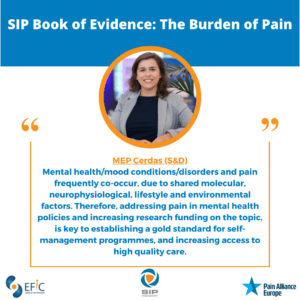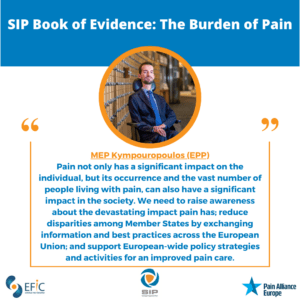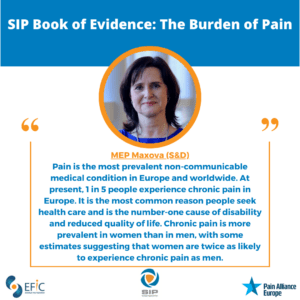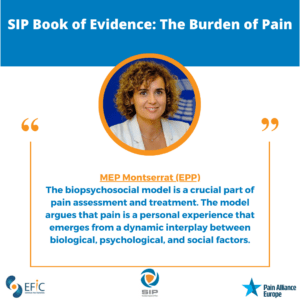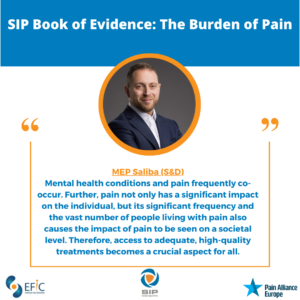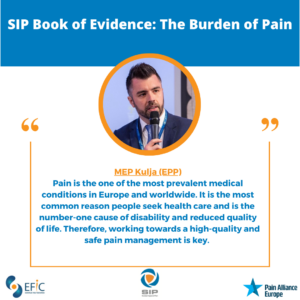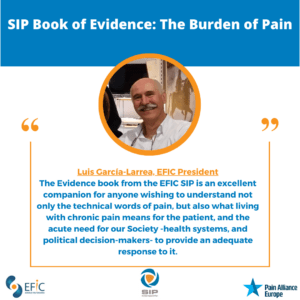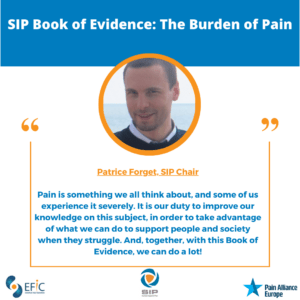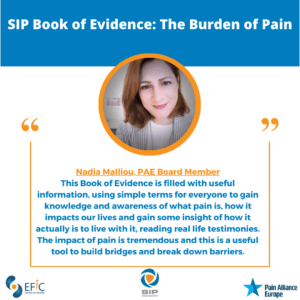SIP Book of Evidence on the Burden of Pain
The Burden of Pain
Pain is the one of the most prevalent medical conditions in Europe and worldwide. It is the most common reason people seek health care and is the number-one cause of disability and reduced quality of life. There is a strong socio-economic gradient in terms of prevalence and impact, particularly for work disability and sickness absence. Disability burden due to pain is escalating, threatening the sustainability of European healthcare and social systems. However, pain research is significantly underfunded compared to other areas of health research and this under-investment is considered a key factor contributing to the burden. The European Commission has called many pain conditions high-burden and under-researched, requiring substantial attention.
In Europe there are approximately 740 million people, most of whom experience an episode of severe pain at some point in their life. For approximately 20 percent, that pain persists for longer than three months and these have chronic pain. Therefore, at present, 150 million people are experiencing chronic pain across Europe, this is approximately equal to the population of Germany and France combined.
The Societal Impact of Pain (SIP) Platform has developed a Book of Evidence entitled ‘The Burden of Pain: A Societal Impact of Pain (SIP) Book of Evidence‘, targeted at individuals from a non-scientific background (e.g. policymakers and funding organisations) to gain an insight into what pain is, understand different definitions used (e.g. acute pain, neuropathic pain, nociceptive pain), and the debilitating effects pain has on patients and societies.
The document explains distinct types of pain conditions (e.g. headaches, low back pain), how common they are, treatment approaches, and common co-occuring health problems, as well as crucial concepts and challenges in the pain field, including pain measurement and assessment, chronic pain stigma, the importance of acknowledging the personal multidimensional nature of pain that requires an appreciation of the interplay between myriad biological/physical, psychological, and sociocultural factors.
Overall, the document describes what pain is and draws attention to the need for urgent policy action and increased funding for research. In particular, the Recommendations highlighted at the end of the document are a call to action to the European Commission, European Parliament, European Council and civil society to address the disastrous societal impacts of pain.
The Societal Impact of Pain (SIP) Platform will continue to raise awareness about the devastating impact pain has on sufferers, societies and economic systems; exchange information and best practices across all members states of the European Union; and develop and foster European-wide policy strategies and activities for an improved pain care paradigm in Europe.
The Burden of Pain: A Societal Impact of Pain (SIP) Book of Evidence
The Societal Impact of Pain (SIP) Platform, calls upon EU and national policymakers to:
- Recognise the burden and impact of pain on societies and patients, and increase its priority within healthcare systems, funding and policymaking.
- Ensure the effective implementation of ICD-11, as its use allows international agreement on the use of standardised diagnosis and tools and improves the recollection of data for both primary and secondary use.
- Ensure patient registries are established and frequently used, as it will improve the understanding of pain and pain management and treatment.
- Pain as a quality indicator: Develop instruments to assess the impact of pain.
- Pain research: Increase investment in research on better understanding the causes (pathophysiology) of various pain conditions, developing novel pain treatments, understanding and addressing comorbidity between pain and mental health conditions, increasing development and use of patient reported outcome measures for all pain conditions, establishing a gold standard for self-management programmes, and increasing access to high quality care.
- Pain in employment: Initiate policies addressing the impact of pain on employment and work productivity and include pain in relevant existing initiatives.
- Pain education: Prioritise pain education for healthcare professionals, patients, policy makers and the general public.
- Information technology for pain: Development of interoperable digital health ecosystems featuring accessible digital solutions for pain evaluation, monitoring and management (apps, online resources etc.) and legal and regulatory frameworks for data sharing.
Download the full Book of Evidence here.
Video Statements
Endorsers and Quotes
